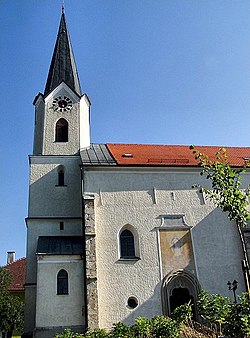
Mauthausen is a small market town in the Austrian state of Upper Austria. It is located at about 20 kilometres east of the city of Linz. The town lies on the banks of the Danube river, opposite the town of Enns, where the major Danube tributary of Enns joins it. During World War II, the town was the site of the Mauthausen concentration camp.

Mauthausen was a German Nazi concentration camp on a hill above the market town of Mauthausen, Upper Austria. It was the main camp of a group with nearly 100 further subcamps located throughout Austria and southern Germany. The three Gusen concentration camps in and around the village of St. Georgen/Gusen, just a few kilometres from Mauthausen, held a significant proportion of prisoners within the camp complex, at times exceeding the number of prisoners at the Mauthausen main camp.

St. Johann im Pongau is a city in the state of Salzburg, Austria. It is the administrative centre of the St. Johann im Pongau District.

Ohrdruf was a German forced labor and concentration camp located near Ohrdruf, south of Gotha, in Thuringia, Germany. It was part of the Buchenwald concentration camp network.

Mattersburg is a town in Burgenland, Austria. It is the administrative center of the District of Mattersburg and was home to former Bundesliga football team, SV Mattersburg.

Lenzing is a small town of approximately 5,000 residents, three kilometers north of Lake Attersee in Austria, It is located in the Upper Austrian part of the Salzkammergut.

The 71st Infantry Division was a unit of the United States Army in World War II.

Frauenkirchen is an Austrian town in the district of Neusiedl am See, Burgenland.

Donnerskirchen is a market town in the district Eisenstadt-Umgebung in the Austrian state of Burgenland.

Ebensee was a subcamp of Mauthausen concentration camp established by the SS to build tunnels for armaments storage near the town of Ebensee, Austria, in 1943. The camp held a total of 27,278 male inmates from 1943 until 1945. Between 8,500 and 11,000 prisoners died in the camp, most from hunger or malnutrition. Political prisoners were most common, and prisoners came from many different countries. Conditions were poor, and along with the lack of food, exposure to cold weather and forced hard labor made survival difficult. American troops of the 80th Infantry Division liberated the camp on 6 May 1945.

Sankt Georgen an der Gusen is a small market town in Upper Austria, Austria, between the municipalities of Luftenberg and Langenstein. As of 2015, the town had 3,779 inhabitants.

Strasshof an der Nordbahn is a satellite town 25 km east of Vienna, Austria. A historical locomotive built by LOFAG is displayed in the town.

Bad Deutsch-Altenburg, until 1928 Deutsch-Altenburg is a market town and spa in the district of Bruck an der Leitha in Lower Austria in Austria.

Gaubitsch is a town in the district of Mistelbach in the Austrian state of Lower Austria.

Hinterbrühl is a town in the district of Mödling in the Austrian state of Lower Austria. It is home to the Seegrotte, a system of caves including Europe's largest underground lake. During World War II, a satellite camp of Mauthausen concentration camp was opened inside the caverns, producing parts for the He 162 Spatz jet fighter.

Père (Father) Jacques de Jésus, OCD, was a French Roman Catholic priest and Discalced Carmelite friar. While serving as headmaster of a boarding school run by his order, he took in several Jewish refugees to protect them from the Nazi government of occupation, for which he was arrested and imprisoned in various concentration camps.

Kaufering was a system of eleven subcamps of the Dachau concentration camp which operated between 18 June 1944 and 27 April 1945 and which were located around the towns of Landsberg am Lech and Kaufering in Bavaria.

James Burdette Thayer was an American brigadier general who served on active duty during World War II. On May 4, 1945, Thayer and his platoon discovered and liberated 15,000 people held at a concentration camp near Wels, Austria. Following the war, he continued his service in the United States Army Reserve. In his civilian life, Thayer founded a successful business supply company in Beaverton, Oregon. He was later appointed Oregon's civilian aide to the Secretary of the Army and then re-activated as commander of the Oregon State Defense Force. The Oregon Military Museum at Camp Withycombe is named in his honor.

Gusen was a subcamp of Mauthausen concentration camp operated by the SS between the villages of Sankt Georgen an der Gusen and Langestein in the Reichsgau Ostmark. Primarily populated by Polish prisoners, there were also large numbers of Spanish Republicans, Soviet citizens, and Italians. Initially, prisoners worked in nearby quarries, producing granite which was sold by the SS company DEST.
Edith Eva Eger is a Czechoslovakian-born American psychologist, a Holocaust survivor and a specialist in the treatment of post-traumatic stress disorder. Her memoir entitled The Choice: Embrace the Possible, published in 2017, became an international bestseller. Her second book, titled The Gift: 12 Lessons to Save Your Life was published in September 2020.





















